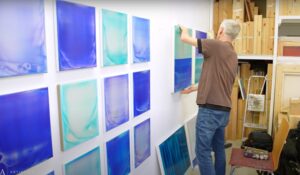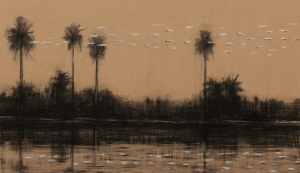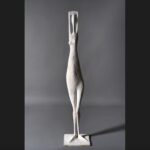The Musée des Arts Asiatiques in Toulon (France) is devoting an exhibition to Taiwanese artist CHEN Yiching until 21 November. This is an opportunity for the public to see around twenty of her paintings and to learn more about Nihon-ga, a traditional Japanese art form that is little known in the West.

Below is a text written by Guillemette Coulomb, curator of the Musée des Arts asiatiques de Toulon and curator of the exhibition:
The Japanese, known for their extreme sensitivity to nature and particularly to the passing of the seasons, will be celebrating “Hanami” (contemplation of flowers) at the beginning of spring, as they do every year. This custom celebrates the return of spring and the blossoming of the sakura cherry trees, which transform Japanese streets, parks and gardens into a fragrant white paradise, where traditional festivals are held.
At the same time, and not by chance, the Musée des Arts asiatiques in Toulon will be celebrating the return of spring with an exhibition of paintings by contemporary artist Chen Yiching. Her works are a hymn to the grandeur and beauty of nature.
The titles she gives them are evocative of the strong bond between the artist and this world of plants: “Hanami” immaculate in transparent white, “Eclat” a shower of shooting stars, “Voile printanier” with its bluish-mauve wisteria covered in a pearly veil, “Hiver” proudly displaying its Ginkgo as a sun, “Cosmos” heralding the colours of summer and the return of the warmth…
Against a white background, Yiching delivers the songs and colours of the seasons to bring out all the splendour and mystery of nature. The pictorial language is reminiscent of ballerinas’ ” tours chainés déboulés“, with the colours blending into the line to give us a vision of movement. Far Eastern painters never present nature as static; it is animated by a breath, the “QI”.
Yiching uses the traditional Japanese ‘Nihon-ga’ painting technique and is one of the few contemporary Asian artists living in France to have mastered all its richness.
This technique, which originated in China during the Tang dynasty, influenced Japanese art to the point where, after numerous Japanese innovations in the 16th and 17th centuries, it became a traditional art form. It was not until the Meiji era that the term Nihon-ga came into use in contrast to Yo-ga, the term used to describe Western-style painting.
Mastering this technique requires many years of practice and exceptional expertise in the use of natural pigments, such as mother-of-pearl, gold leaf and silver leaf and so on.
Far from being locked into the Japanese pictorial tradition, Yiching devotes her soul to it, her originality as a painter and poet and her remarkable mastery of Nihon-ga. Tales of a profound life, shared with nature, that will stand the test of time without ever growing old.
Guillemette Coulomb
Curator of the Toulon Museum of Asian Art
Curator of the exhibition
>>> View CHEN Yiching’s gallery <<<



JAPANESE NIHON-GA PAINTING
When Japan launched its cultural and political reform in the 7th century, students sent to China brought back the literature and arts of the powerful Tang dynasty. This is how the colourful portraits of Buddhas, women and the theme of nature began to exert their influence on Japanese art, which gradually reappropriated them on the basis of its own sensibility.
It was then talented artists (Kano school, Ogata Kôrin, Yokoyama Taikan, Uemura family) who developed its uniqueness. It was not until the 19th century and the Meiji era, however, that the cultural opening that accompanied the modernisation of the country was accompanied by a retreat into identity, giving rise to the notion of nihon-ga (“Japanese painting”, as opposed to “Western painting” known as yô-ga).
The tools and materials are drawn from the mineral, plant and animal kingdoms. A wooden panel, usually covered with paper, is the standard support. It can also be silk or even shell.
Pigments are made from rocks, but also from earth, plants or even insects, reduced to powders of different sizes: blue from azurite or lapis lazuli, white from shells, verdigris from malachite, cochineal producing carmine, indigo a blue, and so on.
The binder used to make the colours is a gelatine, either animal (skin, bone) or vegetable (seaweed), diluted with water.





